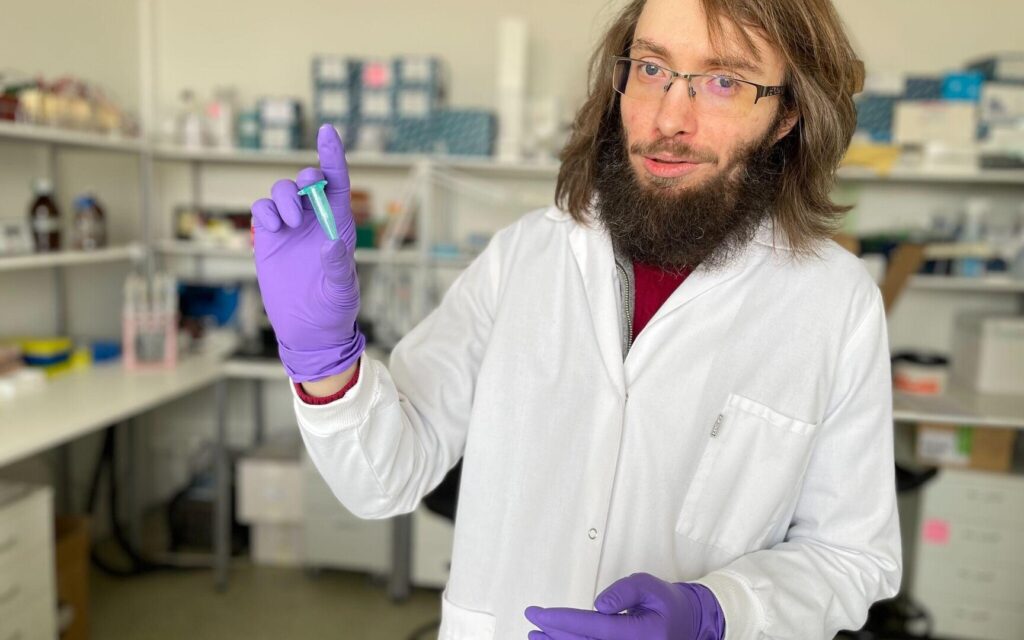As a result of the rapid development of science, new biotechnological methods are constantly emerging, which in turn give rise to several interesting fields of biomedicine. Among them, one of the fastest developing directions is bioinformatics, which can, among other things, design antibodies suitable for the treatment of various diseases.
Among others, the Estonian biotechnology company Dxlabs focuses not only on the production and sales of antibody-based products but also on development. In the long term, they hope to be able to develop products that would predict the risk of developing diseases in still-healthy people. At the same time, patients who are already sick could be properly diagnosed and treated with antibodies.
Information flow of biological systems
To advance biomedicine, it is necessary to understand the processes taking place at the cellular level. However, the use of genetic and molecular studies in cell biology makes the work extremely research-intensive. That’s why Jürgen Tuvikene, a researcher at Tallinn University of Technology’s Institute of Chemistry and Biotechnology, started working in Dxlabs a couple of years ago with the support of the intersectoral mobility (SekMo) measure of the Estonian Research Council.
“Biomedicine is actually just medicine, with the “bio” being redundant there,” explained Tuvikene. “When people talk about biomedicine today, they mean the medical achievements of molecular and cell biology as a scientific field or the research trends entering the medical field. However, bioinformatics plays an important role in all of this.”
“While one clinical test is usually used to find out whether certain antibodies are present in our body, the MVA technology makes it possible to broadly determine all the different antibodies we have in the sample and draw conclusions from this,” he added.
“It is a branch of science where researchers use IT methods to analyse biology and information about biological systems. We, for example, use these methods to gain knowledge about the functioning of the immune system.” However, the amount of information obtained using today’s methods is very large. Thus, IT tools and methods must be used to process data, find connections and use the processes in biological systems to benefit humans.
According to Tuvikene, the problem with antibody-based products is not their production but the question of which products are sensible to produce and market. This is the problem he is trying to solve in the company.
Currently, the main focus of his work is the product development of antibodies related to the human nervous system and its diseases. Basically, it is possible to produce antibodies that help prevent, diagnose, and treat various diseases of the nervous system, as well as antibodies that other researchers can use.
The details of the research can be difficult for the average person to grasp. Looking at the bigger picture, however, it is ultimately aimed at the benefit of all humanity. For example, antibodies related to the cause of a nervous system disease can be identified during disease diagnosis. From this, one can proceed to the development of medication or a vaccine.
Antibody research software
Dxlabs collaborates with the Estonian biotech company Protobios, which is developing a method known as mimotope variation analysis (MVA) to study the antibody response.
MVA is based on the phage display method, which earned its creators the Nobel Prize in 2018. This method uses bacteriophages, small bacteria viruses, that are harmless to humans. Their surface is covered with small proteins containing random amino acids. These surface proteins can bind human blood antibodies in a test tube. Once the antibodies are bound, researchers can use modern sequencing methods to identify which antibodies were attracted to the protein fragments on the surface of bacteriophages.
The magic of the method lies in its ability to study antibodies in various tissue fluids (usually blood) on a very large scale. Correlations with various disease states can then be derived from antibody profiles. For example, many antibodies in human blood protect against various pathogens.
“With the help of MVA, it is possible to obtain the immune profile of antibodies for each person. While one clinical test is usually used to determine whether certain antibodies are present in our body, such as antibodies against the coronavirus, the MVA technology makes it possible to broadly determine which antibodies we have in the sample and draw conclusions from that.”
Thus, approximately three million antibody targets can be obtained from just one blood sample. Without bioinformatics tools, getting a handle on this huge amount of data would be almost impossible. “We hope that as a result of our work, one day cheap and easy diagnosis of diseases or, figuratively speaking, determining a person’s health status and potential disease risks with the help of three drops of blood will be possible,” the researcher said.
Relationship between antibodies and diseases
Jürgen Tuvikene is working on the creation of a bioinformatic analysis method at Dxlabs that would enable the use of immune response profiling data obtained from MVA analysis in cooperation with Protobios for the design of antibody products. To streamline this, it is necessary to create analysis software that is as automatic and universal as possible. After completion, it could be used in the future to determine antibodies in the detection of various health conditions and to choose which antibodies to produce based on the information obtained.
“Currently, for example, we are investigating early biomarkers of schizophrenia. We are trying to find an answer to the question of whether any antibodies make it possible to say that a person is at risk of schizophrenia before they actually get it,” Tuvikene said on the practical directions of the applied research.

Bioinformatician Jürgen Tuvikene can map out about three million antibody targets in one such tube. Author/Source: Marian Männi
The researcher considered the use of antibodies in early diagnosis or disease prevention to be a research area with great potential. “Ideally, the broad-based immune profiles obtained by the MVA method could be the basis for the search for very specific antibodies that contain clinically interesting information,” he noted.
The process could look like this in the future: an analysis is taken in a clinic, inserted into a machine for testing, and a specific assessment of the disease risks arising from the person’s immune system comes out. The same principle could be used to develop tests for the detection of various pathogens. The simpler and cheaper the technology, the better.
In this way, Jürgen Tuvikene’s bioinformatic development of antibody products is aimed on the one hand at clinics and on the other at researchers, who can then use the new antibodies in their research. In addition, MVA technology allows for measuring and understanding the targets of a particular antibody. Once the targets of the antibodies are known, validated, and proven, the market value of such antibodies increases significantly in the eyes of researchers, as this increases the product’s credibility.
“Our role is primarily to find antibody biomarkers that can detect the disease and then to collaborate with pharmaceutical companies,” Tuvikene stated. The final development of clinical tests, drugs, or vaccines should be left to pharmaceutical companies first because it’s too expensive for small businesses to do on their own. And secondly, pharmaceutical companies have the experience and skills to conduct clinical trials and other experiments.
Three research directions
In cooperation with Protobios, Jürgen Tuvikene’s work has three research directions – nervous system diseases, cancer, and cardiovascular diseases.
More specifically, for the first group, the antibodies could be useful in Parkinson’s disease research. Possibilities for early diagnosis of the disease are being vigorously explored because, currently, most people only get a diagnosis once the brain has already suffered a lot of damage. If Parkinson’s could be detected before significant damage occurs, treatment would be much more effective. We wouldn’t have to deal with slowing down the disease and mitigating the damage at the same time.
Another important nervous system disease under investigation is multiple sclerosis. It starts with the person’s own immune system, which then attacks the nervous system. It is not yet clear what causes the immune system to behave like this. However, the development of the disease has been associated with many different pathogens. Among other things, antibodies may be key to understanding the disease’s development.
In cancer research, studying antibodies could help with an earlier cancer diagnosis. Experience so far has shown that the earlier cancer is detected, the more effective the treatment. There are many unsolved questions in cancer treatment.
Changes that can lead to cancer occur in cells and in the whole organism all the time. In most cases, the cells and the immune system can successfully deal with them. If the immune system develops cancer-specific antibodies, it could lead to early detection of cancer in a blood sample or signal when the immune system is no longer able to control pre-cancerous conditions.
Myocardial infarction is also an important research topic. Both obesity and high blood pressure are important risk factors for cardiovascular diseases. At the same time, researchers have found in studies that the immune system can also play a role in them.
“Once, it was hoped that we could easily predict and diagnose all diseases by knowing the human genome. Today, we know that this is mostly not true because the environment also plays a role in the development of diseases. It is the immune system that is one of the main mediators of the effects of the external environment,” said Tuvikene.
“Our analyses also show that genes can influence the human body’s ability to produce antibodies against various pathogens. The relationship between genetic information and the immune system explains why some people suffer from certain infectious diseases more severely while others have it easier,” the researcher added. According to him, it is not enough to simply look at a person to understand the relationship; complex and precisely targeted research is also needed.
Written by: Ain Alvela
This article was first published at the Estonian Public Broadcasting science news portal Novaator and was funded and translated by the European Regional Development Fund through Estonian Research Council.
 Back
Back



